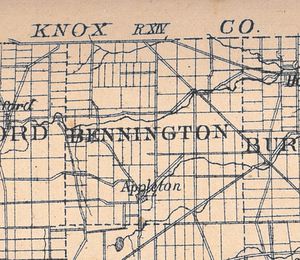Bennington Township
Click here to find census information on Bennington Township.
First Settlers
The first white settler in what is now Bennington Township was Henry Iles, who settled in the area in the spring of 1809. In 1810, two more men, John Dripps and Isaac Vanausdel settled near the North Fork. In the same year, John Trout settled near Otter Fork, and Peter Staymates settled there soon after. The area began to quickly become populated, and by 1835 nearly all of the township had become occupied, divided into many farms. The earliest town or settlement was known as “Cook’s Settlement,” which was in the area of present-day Appleton and was settled around 1812. The settlement was formed by Titus Knox and Captain Cook. Many of the early settlers in the area included the Van Fossen family, Jesse Smith, Jacob Clem, the Wright family, the Sanger family, the Carver family, the McClintock family, and Fishburn family, and the Trout family.
Township Firsts
The first schoolhouse was a log building that was built in the area that would eventually become Appleton. The teacher was Joseph Kerr. The first blacksmith shop was established by a Mr. Snyder, who moved away soon after. John Cooper took over the shop and became the permanent blacksmith. The first mill in the township was built by Jesse Van Fossen about a half mile north of Appleton, on a small stream that was known as Indian Run. This was a saw mill. The second mill, which was the township’s first grist mill, was built by John Denty at the junction of Indian Run and Lake Fork. Denty’s mill was both a grist mill and a saw mill. The first church services were held in the old log schoolhouse. The group that worshipped there belonged to a Christian sect referred to as New Lights. On August 16, 1835, the first church building, a frame structure, was dedicated in Appleton. Reverend Isaac N. Walters preached the sermon at the church’s dedication.
C.S.
Return to Townships and Communities main page.
References
N.N. Hill, Jr., History of Licking County, O.: Its Past and Present (Newark, OH: A.A. Graham & Co., 1881), 397-400.
